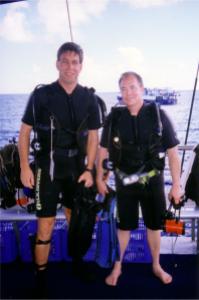 I’ve read a couple of books lately where the author, critically injured in an accident, experiences what seems to be a visit to heaven, followed by a swift return to Earth. The most recent such book was Flight to Heaven, by CAPT Dale Black, a plane crash survivor.
I’ve read a couple of books lately where the author, critically injured in an accident, experiences what seems to be a visit to heaven, followed by a swift return to Earth. The most recent such book was Flight to Heaven, by CAPT Dale Black, a plane crash survivor.
A common theme in these books is that the author finds colors in Heaven to be much purer and vibrant than any colors seen on Earth. Well, I know a place just like that, and for a diver it must indeed be heaven on Earth. It’s called the Red Sea.
Sharm el-Sheik and Ras Muhammad are located on the southern tip of the Sinai Peninsula, where the Gulf of Suez and the Gulf of Aqaba meet the Red Sea. On my first dive at Ras Mohammed, as I sank below the water’s surface I saw a wall of color that defied description. The phrase, “a riot of color”, is a cliché, but that is what I saw. It was as if every inch of the reef was shouting for attention, clamoring to be the most colorful, the most interesting piece of rock ever created. I was stunned — in sensory overload from the beginning to the end of that dive.
At Ras Muhammad, the coral encrusted wall dropped at a dizzying angle, headed for depths of 3000 feet, 1000 m, a very short distance from shore. I had planned a dive to no more than sixty feet, where the natural light was bright enough to show off the colors cascading downward, towards what seemed to be a bottomless abyss. But at sixty feet I saw a never ending waterfall of fauna, just a few feet below me, and then below that, even more. The colors were still spectacular even at that depth, defying all the laws of physics as I understood them.
When I realized I was twenty feet below my planned dive depth, a curious thing happened. I stopped searching for the next most beautiful thing, stopped my descent, but for a few moments I had an almost overwhelming desire to throw rational thought aside and continue down into the abyss.
I understood the consequences of that action, had I continued deeper, but the experience in that moment seemed to transcend my worth as a human being. The living communal organism, and all the life forms sustained by it, clutching close to the wall, seemed to have much greater significance in the whole scheme of things than I did. I felt a kinship, perhaps pointing to our theorized evolutionary beginnings, that made it seem that where I was, was where I belonged.





